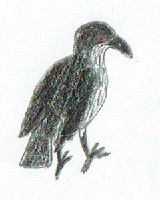THE ROBBER STARLING (Lestornis inexorabilis)
Jabbering and wailing, jinking and subterfuging, the Robber Starling is one of the most characterful, and certainly the most vicious, of the Sandy Island birds. It ranks at the top of the island’s passerine pecking order, and is one of the few reasons other endemic Sandinian birds adapt their calls into alarm calls. It is a large starling, about 10 inches long, and though clearly related it differs sufficiently from the most speciose local genus of starlings, Aplonis, to warrant placement in its own genus. The Robber Starling has a heavy slightly curved bill and a short square-ended tail. The coloration is sombre and funereal: males have very matte black upperparts, with white throat and underparts heavily streaked with the same black except in the middle of the lower belly. Females have the same pattern but brown and buffy-beige instead of black and white. Both sexes have piercing red eyes, as fits their character. Juveniles resemble adult females, but more blendy in color pattern with dark eyes.
The Robber Starling is a classic example of the island large-muscicapoidean niche of a merciless egg-eater, as in the Rodrigues Starling, Galapagos mockingbirds, and Tristan Hermit Thrush. The starlings eat just about any eggs they see and can take; only the Giant Pigeon and Bare-chested Parrot are immune to their plunderings. In the absence of eggs, starlings will scavenge carrion; the young are fed on insects. Though they seem so antisocial, Robber Starlings do not eat each other’s eggs. This means that they are susceptible to parasitism from Giant Fantails, so what appears to be an altruistic adaptation might be improperly thought through; starlings would benefit from eating the fantail eggs that show up in their nests. The starlings do eat fantail eggs, however; woe betide the thrush, woodswallow, or whistler who is unlucky enough to have its nest set upon by first fantails and then starlings! That may be all for the best, though; because starlings generally eat entire clutches, the parent hosts are saved from having to deal with outcompeting parasite chicks. Fantail eggs appear no less tasty to starlings than any other eggs.
Robber Starlings hunt in packs, and are social throughout the year. They nest communally, collaborating to build strange “apartment complexes” of sticks that sometimes bind multiple trees or shrubs together. Each pair in such a complex has its own nest hole, with the entrance on the side. The Robber Starling has many calls, but none are mellow or otherwise pleasant. A metallic jabbering is perhaps the most common, but wails like fingernails on a blackboard (or a scratchy theremin, or maybe a Pine Siskin at 1/10th speed), a drawn-out rasp similar to a distorted, supersized Red-winged Blackbird, and a jumble of syllables not unlike a malfunctioning Furby are also frequently heard. Less often, high-pitched “pitch”, two-syllable “chock-chitch”, and a careening downslur very reminiscent of a car alarm are uttered by Robber Starlings.
In addition to being an egg thief, the Robber Starling exhibits several other behaviors that make it unpopular with other birds - and people! Flocks of starlings will fly very fast in thick brush, bumping aside everything in their way. Starlings will also get uncomfortably close to other birds that are just minding their own business. Their nests take up a lot of space, and are occasionally built over or around other birds’ nests. This generally happens if these other nests have eggs, which the starlings eat before engulfing the nest in their own sticks. “Evil” is a word not frequently associated with birds, but in the case of the Robber Starling, it seems particularly apt.







